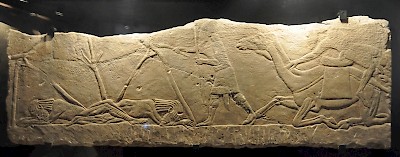Qedar
Q2287491
The Qedarites were a tribal federation living in what is now the desert of Syria, Iraq, Saudi-Arabia, and Jordan. Using dromedaries, they would roam along the Wadi Sirhan from the Duma oasis in the south, their main religious center, all the way up north to the Tadmor oasis (Palmyra). Typically, the Qedarites were ruled by a king and a priestess. According to the Bible, these rulers traded lambs, sheep, and goats.note
The Qedarites are mentioned several times in Assyrian sources. In 737, they paid tribute to Tiglath-Pileser III. Towards the end of the eighth century, they supported Marduk-apla-iddina II (the Merodach-Baladan of the Bible) in his attempts to replace the Assyrians as rulers in Babylonia. This was not the last time that Qedar allied itself to a Babylonian ruler revolting against Assyria.
In about 690 BCE, king Sennacherib led his armies against the Qedarites, which were commanded by their king Hazael and a priestess named Te’elhunu. They were driven back to Duma and were forced to extradite the priestess and hand over the statues of the gods, which were sent to Nineveh. King Hazael remained as ruler of the tribe and would eventually ask Sennacherib’s son and successor, Esarhaddon, for the return of the statues. Esarhaddon was willing to consider this but raised the annual tribute and sent a new priestess, a woman named Tarbua, to Duma.
Not much later, Hazael was succeeded by his son Yautha‘, who had to cope with an insurrection among his tribes led by one Wahb. Assyrian support made him win this domestic conflict but once his throne was secure, he revolted as well. The Assyrians took him captive but allowed him to return after the death of their king Esarhaddon (669 BCE) and the succession of Aššurbanipal. It is likely that this was somehow connected to Esarhaddon’s unfortunate legacy, the war in Egypt. The country of the Nile had been occupied but turned out to be hard to control. It is possible that the return of Yautha‘ was meant as a way of securing the lines of communication.
If this was Aššurbanipal’s goal, he turned out to be wrong. Yautha‘ allied himself to Šamaš-šuma-ukin, Aššurbanipal’s brother and the king of Babylonia. Together with another Qedarite leader, a man named Ammuladi, Yautha‘ attacked Assyria’s western provinces. The Qedarites were defeated by the Moabites, loyal allies of Assyria, and Yautha‘ was forced to flee to king Natnu of the Nebayot tribal federation in Tayma. Natunu convinced his guest to return to Nineveh.
This was not the end of the conflict yet. Two new Qedarite leaders, Abyatha‘ and Ayamu, the sons of Teri, continued to support Babylonia. They were eventually defeated and besieged. Abyatha‘ surrendered and was made sole successor of Yautha‘.
And still, the conflict was far from over. In 641, the tribes of Qedar and those of Nebayot united in what was called the “confederation of Atarsamain”, named after the goddess venerated in Duma. Again, the Assyrians overcame the resistance. In 638, they replaced the king of Nebayot by his son Nuhuru.
It is possible that the Qedarites expanded their power after the demise of the Assyrian Empire and the rise of the Babylonian Empire.